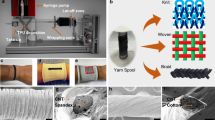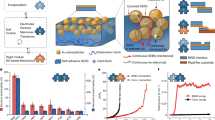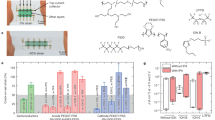Abstract
On-skin and implantable electronics require elastic conductors that are only a few micrometres thick and soft enough to form a seamless contact with three-dimensional structures. However, fabricating thin conductors that are mechanically durable and have consistent electrical properties with stretching is challenging. Here we report polydimethylsiloxane (PDMS)–gold conductors that are around 1.3 µm thick and have a controlled morphology of microcracks in the gold film. The microcracks are formed by evaporating a 50-nm-thick gold film onto a 1.2-µm-thick PDMS film that is supported during fabrication by a 100-µm-thick PDMS film on glass; thermal expansion of the thick PDMS film causes the evaporated gold to form a microcracked structure on the thin PDMS. The resulting conductors can be stretched by up to 300% and remain highly conductive after strain release. We use them to create on-skin electrodes that are breathable and water resistant, and can continuously record electrocardiogram signals. We also use the conductors to create on-skin sensors with less than 3 µm thickness that can detect small mechanical forces and create implantable nerve electrodes that can provide signal recording and stimulation.
This is a preview of subscription content, access via your institution
Access options
Access Nature and 54 other Nature Portfolio journals
Get Nature+, our best-value online-access subscription
$29.99 / 30 days
cancel any time
Subscribe to this journal
Receive 12 digital issues and online access to articles
$119.00 per year
only $9.92 per issue
Buy this article
- Purchase on Springer Link
- Instant access to full article PDF
Prices may be subject to local taxes which are calculated during checkout




Similar content being viewed by others
Data availability
The data that support the findings of this study are available from the corresponding authors on reasonable request.
Code availability
The codes used for analysing the neural signals are available from the corresponding authors upon reasonable request.
References
Kim, D. H. et al. Dissolvable films of silk fibroin for ultrathin conformal bio-integrated electronics. Nat. Mater. 9, 511–517 (2010).
Liu, J. et al. Syringe-injectable electronics. Nat. Nanotechnol. 10, 629–636 (2015).
Lee, S. et al. Nanomesh pressure sensor for monitoring finger manipulation without sensory interference. Science 370, 966–970 (2020).
Liu, Y. et al. Morphing electronics enable neuromodulation in growing tissue. Nat. Biotechnol. 38, 1031–1036 (2020).
Jeong, J. W. et al. Materials and optimized designs for human-machine interfaces via epidermal electronics. Adv. Mater. 25, 6839–6846 (2013).
Someya, T., Bao, Z. & Malliaras, G. G. The rise of plastic bioelectronics. Nature 540, 379–385 (2016).
Gao, W., Ota, H., Kiriya, D., Takei, K. & Javey, A. Flexible electronics toward wearable sensing. Acc. Chem. Res. 52, 523–533 (2019).
Kang, S. K., Koo, J., Lee, Y. K. & Rogers, J. A. Advanced materials and devices for bioresorbable electronics. Acc. Chem. Res. 51, 988–998 (2018).
Matsuhisa, N. et al. High‐transconductance stretchable transistors achieved by controlled gold microcrack morphology. Adv. Electron. Mater. 5, 1900347 (2019).
Lee, G. H. et al. Stretchable anisotropic conductive film (S-ACF) for electrical interfacing in high-resolution stretchable circuits. Sci. Adv. 8, eabm3622 (2022).
Jiang, Z. et al. Highly stretchable metallic nanowire networks reinforced by the underlying randomly distributed elastic polymer nanofibers via interfacial adhesion improvement. Adv. Mater. 31, e1903446 (2019).
Matsuhisa, N. et al. Printable elastic conductors by in situ formation of silver nanoparticles from silver flakes. Nat. Mater. 16, 834–840 (2017).
Kim, Y. et al. Stretchable nanoparticle conductors with self-organized conductive pathways. Nature 500, 59–63 (2013).
Son, D. et al. An integrated self-healable electronic skin system fabricated via dynamic reconstruction of a nanostructured conducting network. Nat. Nanotechnol. 13, 1057–1065 (2018).
Chen, Z. et al. Three-dimensional flexible and conductive interconnected graphene networks grown by chemical vapour deposition. Nat. Mater. 10, 424–428 (2011).
Choi, S. et al. Highly conductive, stretchable and biocompatible Ag–Au core–sheath nanowire composite for wearable and implantable bioelectronics. Nat. Nanotechnol. 13, 1048–1056 (2018).
Jung, D. et al. Highly conductive and elastic nanomembrane for skin electronics. Science 373, 1022–1026 (2021).
Liu, S., Shah, D. S. & Kramer-Bottiglio, R. Highly stretchable multilayer electronic circuits using biphasic gallium-indium. Nat. Mater. 20, 851–858 (2021).
Ma, Z. et al. Permeable superelastic liquid-metal fibre mat enables biocompatible and monolithic stretchable electronics. Nat. Mater. 20, 859–868 (2021).
Wang, Y. et al. Robust, self-adhesive, reinforced polymeric nanofilms enabling gas-permeable dry electrodes for long-term application. Proc. Natl Acad. Sci. USA 118, e2111904118 (2021).
Lacour, S. P. et al. Mechanisms of reversible stretchability of thin metal films on elastomeric substrate. Appl. Phys. Lett. 88, 204103 (2006).
Zhang, B. et al. Stretchable conductive fibers based on a cracking control strategy for wearable electronics. Adv. Funct. Mater. 28, 1801683 (2018).
Liu, Z. et al. Highly stable and stretchable conductive films through thermal-radiation-assisted metal encapsulation. Adv. Mater. 31, e1901360 (2019).
Johnston, I. D., McCluskey, D. K., Tan, C. K. L. & Tracey, M. C. Mechanical characterization of bulk Sylgard 184 for microfluidics and microengineering. J. Micromech. Microeng. 24, 035017 (2014).
Liu, M., Sun, J. & Chen, Q. Influences of heating temperature on mechanical properties of polydimethylsiloxane. Sens. Actuator A Phys. 151, 42–45 (2009).
Hadgraft, J. & Lane, M. E. Transepidermal water loss and skin site: a hypothesis. Int. J. Pharm. 373, 1–3 (2009).
Geerligs, M. A literature review of the mechanical behavior of the stratum corneum, the living epidermis and the subcutaneous fat tissue (Philips Research, 2006).
Lee, H. et al. Stretchable organic optoelectronic devices: design of materials, structures, and applications. Mater. Sci. Eng. 146, 100631 (2021).
Miyamoto, A. et al. Inflammation-free, gas-permeable, lightweight, stretchable on-skin electronics with nanomeshes. Nat. Nanotechnol. 12, 907–913 (2017).
Yang, X. et al. Bioinspired neuron-like electronics. Nat. Mater. 18, 510–517 (2019).
Mariello, M., Kim, K., Wu, K., Lacour, S. P. & Leterrier, Y. Recent advances in encapsulation of flexible bioelectronic implants: materials, technologies and characterization methods. Adv. Mater. 34, e2201129 (2022).
Zhang, Y. et al. Stretchable PDMS encapsulation via SiO2 doping and atomic layer infiltration for flexible displays. Adv. Mater. Interfaces 9, 2101857 (2022).
Ji, S. et al. Water-resistant conformal hybrid electrodes for aquatic endurable electrocardiographic monitoring. Adv. Mater. 32, e2001496 (2020).
Jiang, Y. et al. Stretchable, washable, and ultrathin triboelectric nanogenerators as skin-like highly sensitive self-powered haptic sensors. Adv. Funct. Mater. 31, 2005584 (2020).
Liu, Z. et al. Surface strain redistribution on structured microfibers to enhance sensitivity of fiber-shaped stretchable strain sensors. Adv. Mater. 30, 1704229 (2018).
Mariello, M., Fachechi, L., Guido, F. & De Vittorio, M. Conformal, ultra-thin skin-contact-actuated hybrid piezo/triboelectric wearable sensor based on AlN and parylene-encapsulated elastomeric blend. Adv. Funct. Mater. 31, 2101047 (2021).
Park, J., Kim, D. & Kim, Y. T. Ultra-stretchable on-body-based soft triboelectric nanogenerator for electronic skin. Smart Mater. Struct. 29, 115031 (2020).
Chu, Y. et al. Human pulse diagnosis for medical assessments using a wearable piezoelectret sensing system. Adv. Funct. Mater. 28, 1803413 (2018).
Cianchetti, M., Laschi, C., Menciassi, A. & Dario, P. Biomedical applications of soft robotics. Nat. Rev. Mater. 3, 143–153 (2018).
Chen, N. et al. Nanotunnels within poly(3,4-ethylenedioxythiophene)-carbon nanotube composite for highly sensitive neural interfacing. ACS Nano 14, 8059–8073 (2020).
Rijnbeek, E. H., Eleveld, N. & Olthuis, W. Update on peripheral nerve electrodes for closed-loop neuroprosthetics. Front. Neurosci. 12, 350 (2018).
Musick, K. M. et al. Chronic multichannel neural recordings from soft regenerative microchannel electrodes during gait. Sci. Rep. 5, 14363 (2015).
Alahi, M. E. E. et al. Recent advancement of electrocorticography (ECoG) electrodes for chronic neural recording/stimulation. Mater. Today Commun. 29, 102853 (2021).
Acknowledgements
Parts of this work were conducted in RIKEN, Japan, supported by JSPS KAKENHI under grant nos. JP18H05469 and 17H06149. Parts of this work were conducted in Nanyang Technological University, Singapore, supported by the National Research Foundation Singapore (NRF) under NRF’s Medium Sized Centre: Singapore Hybrid-Integrated Next-Generation μ-Electronics (SHINE) Centre funding programme and the Agency for Science, Technology and Research (A*STAR) under its AME Programmatic Funding Scheme (Project #A18A1b0045; X.C.). Parts of this work were conducted in the University of Macau, China, supported by the Science and Technology Development Fund, Macau SAR (FDCT) (file nos. 0059/2021/AFJ and 0040/2021/A1). The implantable experiments were conducted in the National University of Singapore and they were supported by the National Research Foundation, Prime Minister’s Office, Singapore, under the NRF Investigatorship Programme (award no. NRF-NRFI05-2019-0003) and NUS NANONASH Programme (NUHSRO/2020/002/NanoNash/LOA; R143000B43114).
Author information
Authors and Affiliations
Contributions
Z.J., K.F., X.C. and T.S. conceived and designed the research. Z.J. designed the the ultrathin PDMS–Au and performed the characterization of the mechanical, electrical and morphological properties. Z.J., S.J. and F.Z. designed the on-skin ECG sensor and performed the related characterizations. Z.J. and J.Z. designed the ultrathin sensor and performed the related characterizations. Z.J. and N.C. designed and fabricated the neural electrodes, and N.C. and Z.Y. performed the implantable experiments. R.L. and Yang Wang performed the COMSOL simulations. Yan Wang, H.L., Z.L., T.Y. and K.F. assisted in the experiment or analysed the data. All the authors discussed the results and commented on the manuscript. Z.J., K.F., X.L., X.C. and T.S. wrote the manuscript. We would like to thank Y. Jiang, J. Yi, W. Li and C. Cao from Nanyang Technological University and G. Gammad from National University of Singapore for their technical support and discussion.
Corresponding authors
Ethics declarations
Competing interests
The authors declare no competing interests.
Peer review
Peer review information
Nature Electronics thanks Xue Feng, Wei Gao, Massimo Mariello and the other, anonymous, reviewer(s) for their contribution to the peer review of this work.
Additional information
Publisher’s note Springer Nature remains neutral with regard to jurisdictional claims in published maps and institutional affiliations.
Supplementary information
Supplementary Information
Supplementary Figs. 1–46, Tables 1 and 2 and experimental section.
Supplementary Video 1
Laminating the ultrathin PDMS film onto the thick PDMS-coated glass substrate.
Supplementary Video 2
Stretch test of the ultrathin conductor.
Supplementary Video 3
Adhesion test of the ultrathin electrode when the volunteer washed hands.
Supplementary Video 4
Adhesion test of the thick electrode when the volunteer washed hands.
Supplementary Video 5
Resistance measurement on the ultrathin electrode when moving the arm.
Supplementary Video 6
Demonstration of powering a liquid-crystal display using the ultrathin mechanical sensor.
Supplementary Video 7
Selective muscle activation by stimulating the nerve using the ultrathin neural electrodes.
Supplementary Video 8
Selective muscle activation by stimulating the nerve using thick electrodes.
Rights and permissions
Springer Nature or its licensor (e.g. a society or other partner) holds exclusive rights to this article under a publishing agreement with the author(s) or other rightsholder(s); author self-archiving of the accepted manuscript version of this article is solely governed by the terms of such publishing agreement and applicable law.
About this article
Cite this article
Jiang, Z., Chen, N., Yi, Z. et al. A 1.3-micrometre-thick elastic conductor for seamless on-skin and implantable sensors. Nat Electron 5, 784–793 (2022). https://doi.org/10.1038/s41928-022-00868-x
Received:
Accepted:
Published:
Issue Date:
DOI: https://doi.org/10.1038/s41928-022-00868-x
This article is cited by
-
Intelligent perceptual textiles based on ionic-conductive and strong silk fibers
Nature Communications (2024)
-
Ultra-sensitive, highly linear, and hysteresis-free strain sensors enabled by gradient stiffness sliding strategy
npj Flexible Electronics (2024)
-
Well-defined in-textile photolithography towards permeable textile electronics
Nature Communications (2024)
-
Computational design of ultra-robust strain sensors for soft robot perception and autonomy
Nature Communications (2024)
-
Phase-separated stretchable conductive nanocomposite to reduce contact resistance of skin electronics
Scientific Reports (2024)



